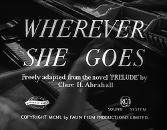 7927947774714300213.jpg
7927947774714300213.jpg
Screen cap from opening credits
Adaptation of
Prelude
1947
single work
children's fiction
Issue Details:
First known date:
1951...
1951
Wherever She Goes

